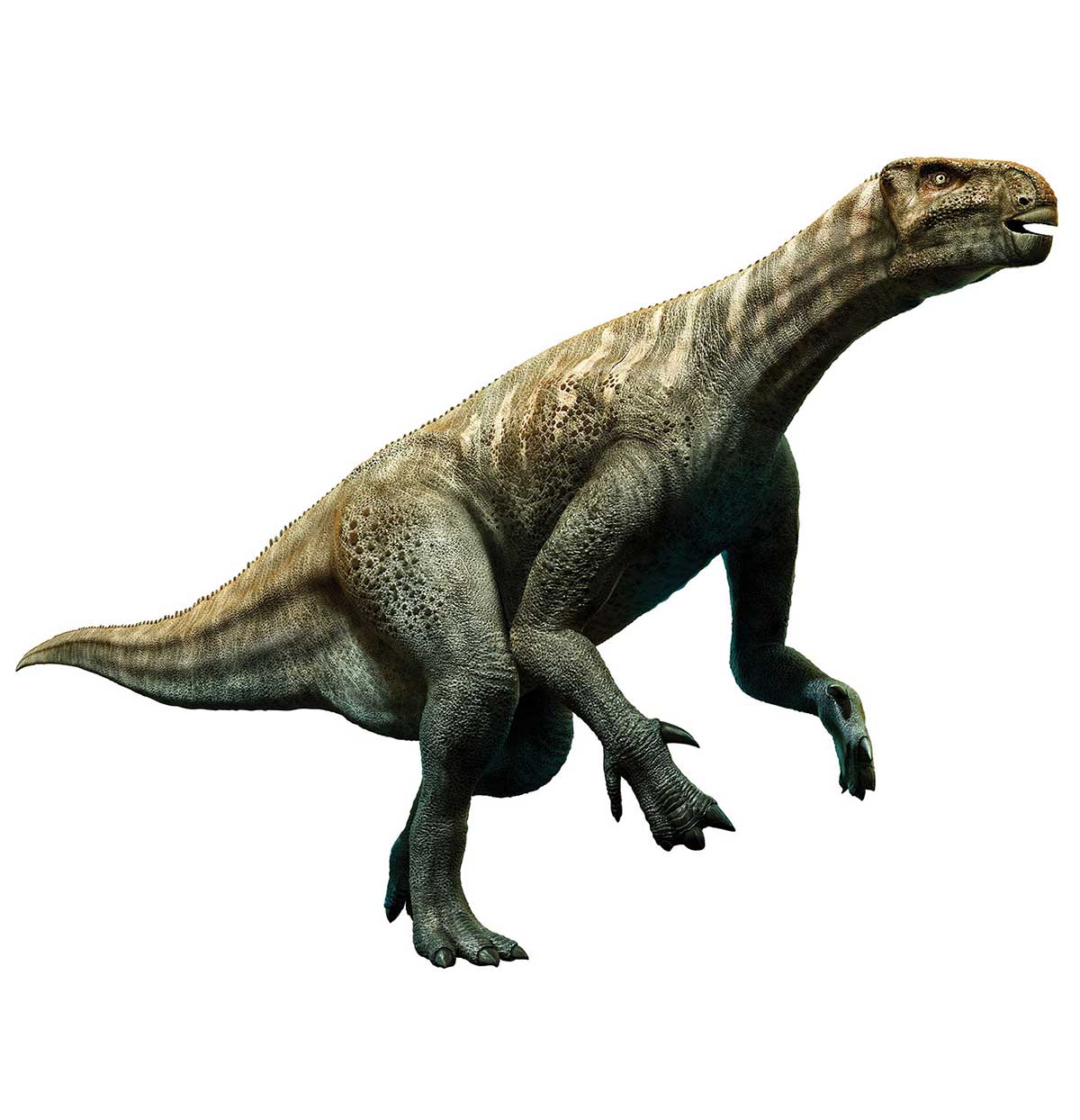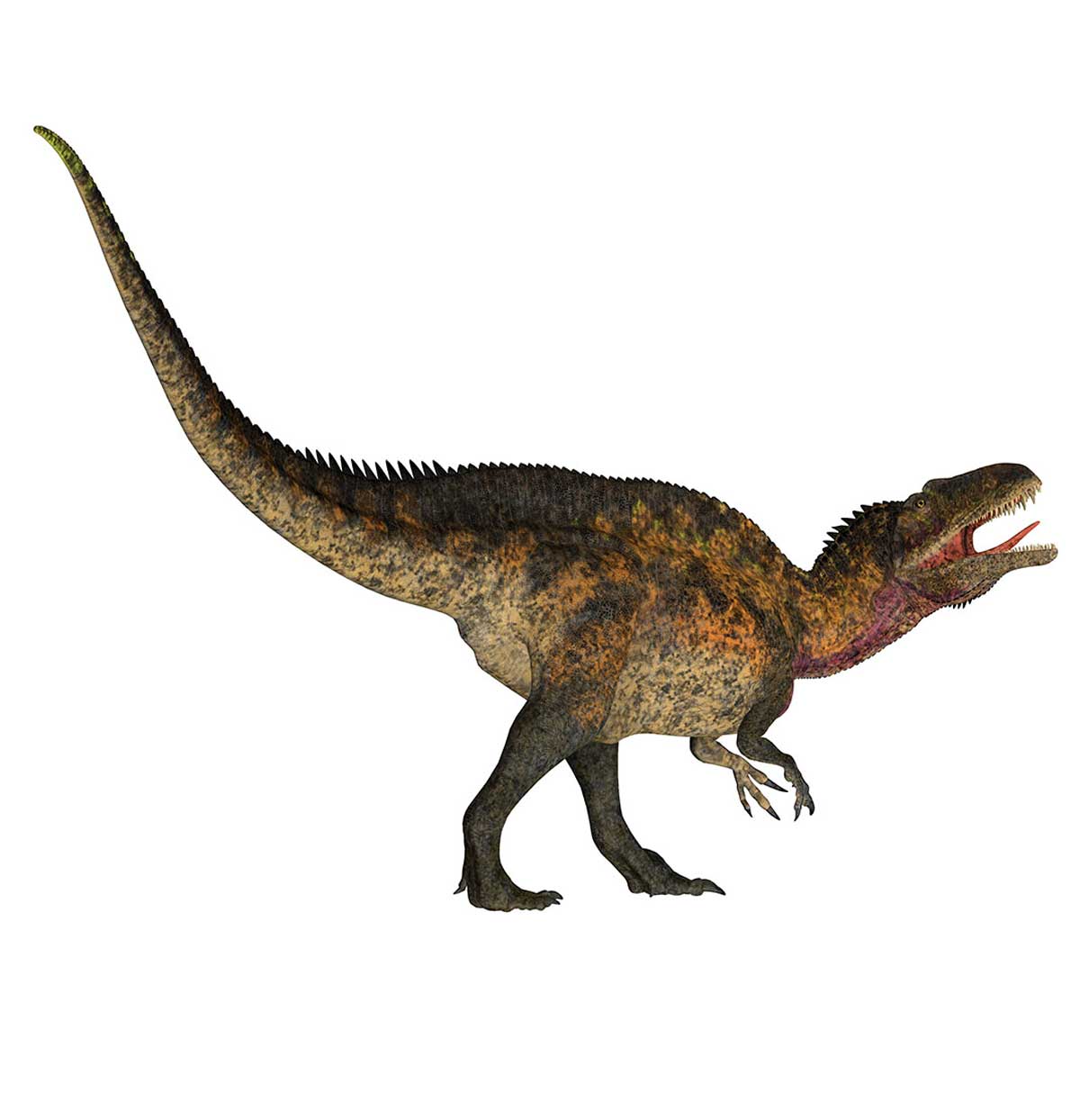
Warpaintcobra | Dreamstime
In the Footsteps of Dinos
Dinosaur tracks across Texas reveal secrets of ancient inhabitants.
I’M TRACKING REPTILIAN GIANTS in the wild at Dinosaur Valley State Park.Park ranger Zach Riggs leads me down a steep trail to the Paluxy River to view the main track site and a spot where traveling paleontologist Roland T. Bird discovered the world’s first sauropod tracks in 1938.
Sauropods, as many dino-savvy grade-schoolers know, are a group of gigantic, quadrupedal, plant-eating dinosaurs with towering necks and long, whip-like tails. They left enormous tracks, wallowed out like washtubs. Birdlike, three-toed tracks of theropods, a group of bipedal carnivores that ruled the Age of Dinosaurs, also crisscross this ancient tracksite in the Paluxy riverbed.
We’re about 113 million years too late to catch the Cretaceous two-stepping action on the mucky edge of a long-vanished shallow sea. But the flurry of fossilized footprints, frozen in time and limestone, brings this dinosaur freeway to life in my imagination.
“In my humble opinion, Dinosaur Valley has some of the best-preserved tracks that you will find,” says Riggs, pointing to a well-defined theropod footprint. “We are a world-class dinosaur track site in the sheer number of tracks, the high number of species and the incredible level of detail.”
Dinosaur Valley, opened in 1970, is the largest, best-known track site in Texas, and the first fossil-focused park of its kind in the Lone Star State. It made nearby Glen Rose famous as the Dinosaur Capital of Texas and helped put Texas on the map as a prime area for paleontological research.
According to Thomas Adams, a vertebrate paleontologist and chief curator at the Witte Museum in San Antonio, Dinosaur Valley “was one of the first dinosaur fossil sites in the world to be opened to the public and was a model for many others that came afterward.”
Adams adds, “There are more than 50 known track sites in Texas across 24 counties. Each site has from one to more than 300 tracks. While there are individual track sites in other states with larger numbers of footprints, Texas has more individual sites overall. Only a handful of these Texas sites are accessible to the public. All told, there are thousands of fossil tracks in Texas, among the largest number of dinosaur footprints in the U.S. and the world. That makes Texas really unique.”

Maegan Lanham | TPWD
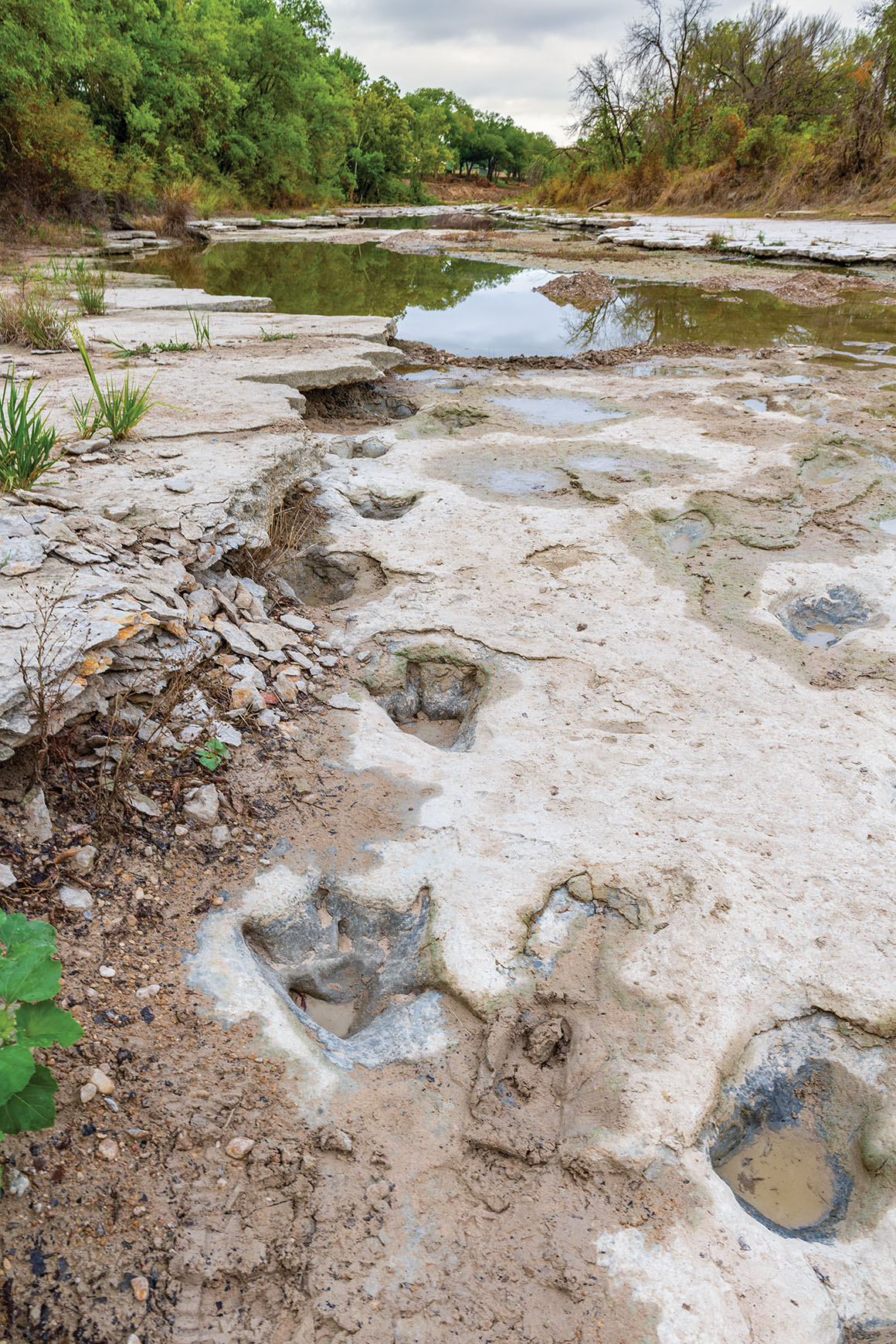
Maegan Lanham | TPWD
Making Tracks
A LIFELONG paleontology enthusiast, I recently visited four major Texas track sites open to visitors: Dinosaur Valley, Government Canyon State Natural Area, San Angelo State Park and the Heritage Museum of the Texas Hill Country. Other Texas track sites worthy of visiting include Canyon Lake Gorge and an unprotected spot on the South San Gabriel River near Leander.
Most fossil footprint sites in Texas, except for San Angelo State Park’s much older Permian tracks, date to the Lower Cretaceous period and range from 104 million to 115 million years old. These dinosaur tracks occur in Glen Rose limestone, which outcrops in washes and riverbeds in a geologic arc tracing the Balcones Escarpment, from Glen Rose south to San Antonio and west to Bandera.
Trekking through these sites, I step back in deep-time to the Cretaceous period and the Age of the Dinosaurs. The ancestral precursor to the Gulf of Mexico inundated what’s now Central Texas, forming a shallow sea with carbonate-rich tidal flats.
Prehistoric track makers walked along the shoreline, leaving footprints in the clay-like mud. Baked by the sun, the exposed footprints hardened, filled in with debris and then were covered by more sediments as sea levels rose. Buried for tens of millions of years, the original shoreline layer lithified, turning into limestone. Leap forward millions more years. Relentless weathering and erosion gradually exposed the fossilized tracks to the light of day — and human curiosity.
Paleontologists classify dinosaur tracks as trace fossils, which also include nests, burrows and coprolites (fossilized scat). Ichnology, from the Greek word ichnos (“trace”), is the scientific study of trace fossils. Specialists in vertebrate paleoichnology focus on dinosaur tracks and trackways — a sequence of consecutive tracks. Once considered a fringe discipline, paleoichnology has blossomed in recent decades, contributing valuable insights into the lifeways of dinosaurs.
Working like geo-detectives, paleoichnologists tease out clues of animal movement imprinted in stone. Field research at track sites sheds light on the size, posture, gait, stride and speed of track makers and provides insight into individual and group behaviors that cannot be gleaned from skeletal remains.
Three primary dinosaur track makers in Texas during the Lower Cretaceous were sauropods, theropods and ornithopods — a group of herbivores that left broad, three-toed tracks. If you see a basin-shaped sauropod track in Texas, a prime suspect is Sauroposeidon proteles, the State Dinosaur of Texas and the tallest known dinosaur, reaching heights of 60 feet. If it’s a large, three-toed track with claw marks, a good candidate is fearsome Acrocanthosaurus (named “high-spined lizard” for its tall neural spines), second largest carnosaur in North America after Tyrannosaurus rex. Other clawless three-toed footprints might be attributed to the hefty ornithopod Iguanodon, one of first dinosaurs ever discovered.
DINOSAUR VALLEY REDUX
DINOSAUR VALLEY ABOUNDS with some of the world’s best-preserved theropod and sauropod tracks. Discovered in 1909, the “bird tracks” were initially regarded as curiosities, not as exciting to paleontologists as dinosaur bones. However, R.T. Bird, the chief fossil hunter for the American Museum of Natural History in New York City, caught wind of the Texas tracks while gathering fossils across several Western states for the museum’s collections and made a detour to Glen Rose in 1938. Locals were happy to show him numerous three-toed tracks.
But Bird wanted to see the other “elephant tracks.” When he discovered basin-sized footprints in the riverbed near theropod tracks, it was a Eureka! moment. Bird’s momentous find — the first sauropod footprints to be recognized anywhere in the world — put Glen Rose on the paleontological map and sparked public fascination with dinosaurs as cultural icons.
The museum sent Bird back to Glen Rose in 1940 to excavate a large segment of sauropod and theropod tracks from the Paluxy River for future display. Bird shipped trackway pieces to his museum (where they remain on display) and to other institutions including the Texas Memorial Museum in Austin.
Bird’s discoveries on the Paluxy River and other Texas track sites changed how paleontologists and the public view dinosaurs. The sauropod trackways proved that these enormous creatures could walk on land, refuting the prevailing belief that sauropods were primarily aquatic. A stomping ground of sauropod footprints near Bandera suggested that sauropods likely traveled in herds, like today’s megafauna on the move. Prior to Bird’s discoveries, paleontologists also believed dinosaurs dragged their tails like lizards. Yet Texas trackways show no tail marks: dinosaurs held their tails aloft while walking.
After a photo op beside the park’s whimsical theropod and sauropod models created for the 1964-65 World’s Fair, Riggs guides me along the Paluxy River to see the main track site, the long scar in the riverbed from Bird’s excavation, and the idyllic Blue Hole and nearby Ballroom site where researchers have mapped hundreds of footprints heading in multiple directions like a Cretaceous dance floor.
In the summer of 2022, extreme drought exposed other tracks in the Paluxy riverbed that had been submerged and unseen for more than 20 years. The international media buzz went viral: Journalists and camera crews flocked to Dinosaur Valley to report on the “new” track discoveries, such as the famous “Lone Ranger” theropod site on the park’s western edge, one of the longest trackways ever found. The exposed footprints, however, were not new finds — they had been documented decades earlier.
TRAILING TRACKS IN GOVERNMENT CANYON
AT GOVERNMENT CANYON State Natural Area northwest of San Antonio, Superintendent Nic Maloukis takes me on a five-mile round-trip hike to the track site. We arrive at three adjacent track areas in the bed of Government Canyon Creek: the Lower Theropod Trackway with 27 tracks, the nearby Sauropod Trackway with 19 footprints, and just upstream, the Upper Theropod Trackway, with more than 200 documented theropod tracks made by 30 creatures. The tracks date back some 104 million years.
“The sauropod footprints used to be our most impressive tracks until we had major flooding a few years ago,” says Maloukis. “While floods cover up some tracks in sediments, they also can expose new tracks at different depths in the limestone.”
Although footprints in limestone may look Texas-tough, they are easily damaged. Cable barriers and signage (“Help save these dinosaur tracks from extinction”) keep visitors out of the trackways.
In 2014, Adams and a team of paleontologists documented 308 footprints at Government Canyon. A replica of the most detailed theropod tracks is displayed beneath an imposing Acrocanthosaurus skeleton in the Naylor Family Dinosaur Gallery at the Witte Museum in San Antonio.
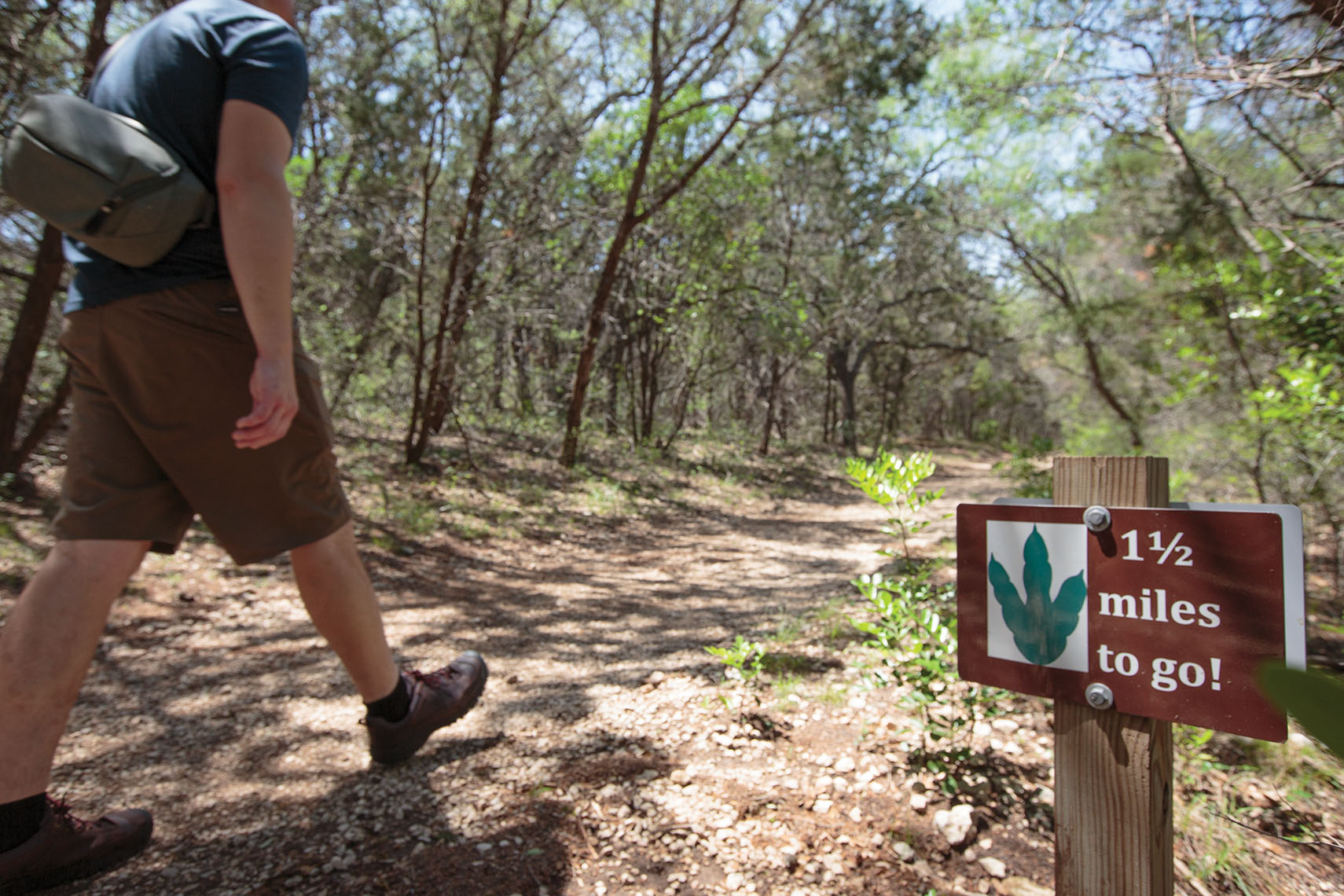
Sonja Sommerfeld | TPWD
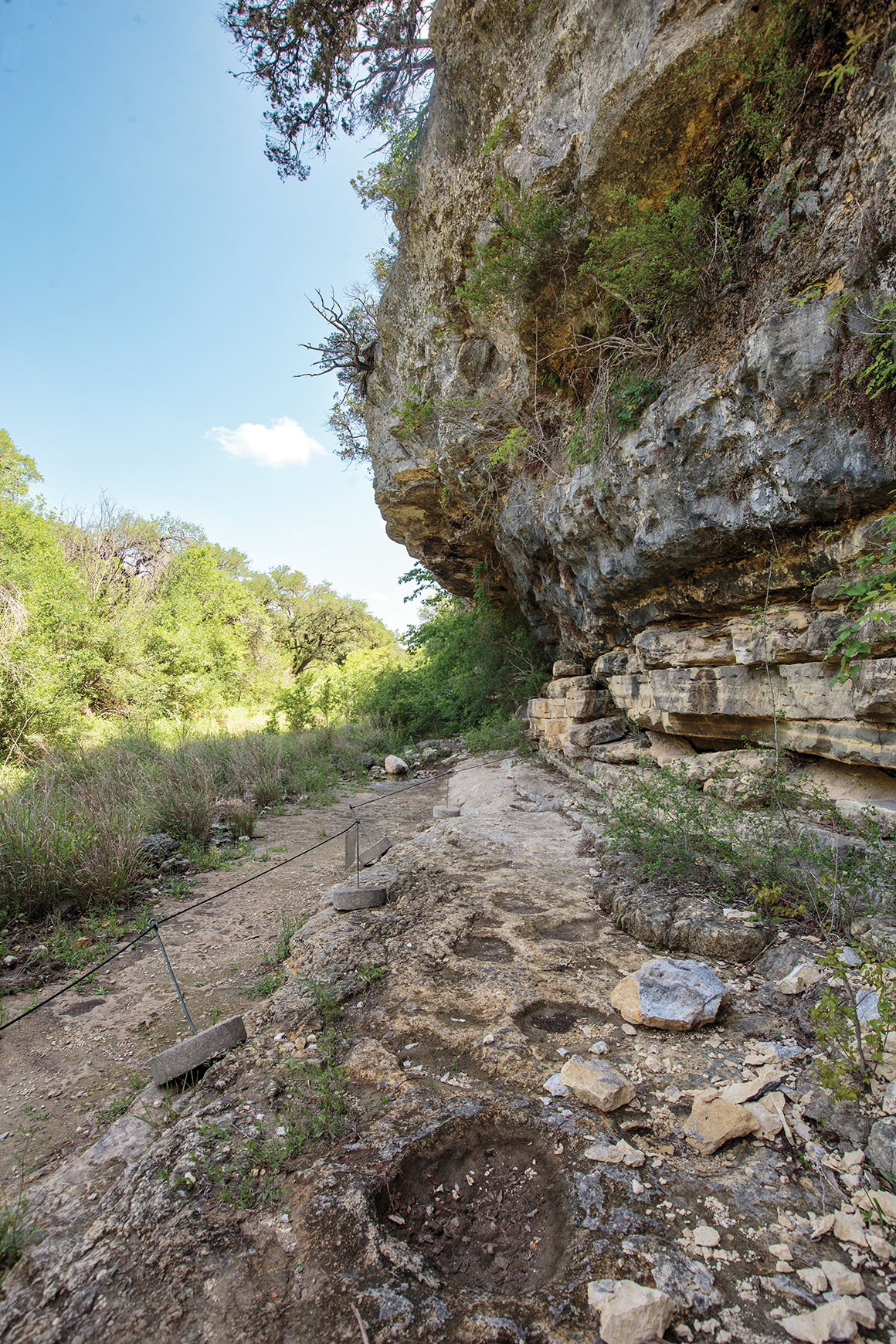
Sonja Sommerfeld | TPWD
LOST PRE-DINOSAUR WORLD
A RARE PREHISTORIC track site discovery in San Angelo State Park predates the more common Early Cretaceous dinosaur footprints by tens of millions of years. Researchers determined the tracks date to the Permian period, making the park one of five known Permian track sites in Texas.
The likely track makers were large, primitive amphibians known as Eryops and reptile-like synapsids, predecessors to mammals, which included sail-backed Dimetrodon. Paleontologists have documented 28 different sets of tracks made by multiple creatures between 300 million and 250 million years ago.
The park’s track site is tucked away in Little Foot Draw, a wet-weather runoff feeding into the North Concho River and O.C. Fisher Reservoir.
“Imagine what it was like in the Permian when this was hot, humid swampland,” says park interpreter Tara Fattouh, who leads guided hikes to Little Foot Draw. “The tracks bring a sense of reality to it.”

Maegan Lanham | TPWD
A HAPPY ACCIDENT
ONE OF THE most recent and important track site discoveries in Texas occurred by accident near Canyon Lake. In 1982, Ken Thayer, a retired postal worker, planned to develop an RV park on his property west of Sattler. Road crews excavated part of the hillside for road fill material and created a level area for Thayer’s future RV park. While playing on the exposed limestone surface, Thayer’s sons realized the three-toed indentations were fossil footprints.
Soon after the track site discovery, geologists and paleontologists documented more than 200 dinosaur tracks and 28 separate trackways, as well as scrape marks from a large, prehistoric snail, in the 110-year-old Glen Rose formation. Likely candidates for the two types of three-toed tracks: Acrocanthosaurus and Iguanodon.
Thayer ditched his RV plans and operated the site as a theme park, Dinosaur Flats, for about 10 years. Then by the late 1990s, the Heritage Museum of the Texas Hill Country, a nonprofit museum dedicated to preserving the natural and cultural heritage of the Canyon Lake area, needed a permanent home with room to grow for its pioneer-era collections. The Cretaceous track site needed preservation and protection from the elements, so it was a proverbial match made in heaven.
The museum opened in its new home in 2000, and over the years has expanded to more than 25 acres. In 2008, it added a large pavilion to cover and protect the track site. The Heritage Museum is now Texas’ largest track site in a museum-like setting.
I was fortunate to visit the museum during Dinosaur Day, a family-friendly, dino-themed celebration held each year in late March, featuring guided tours of the track site, fossil hunts and scores of nature-oriented exhibits. Adams, who serves as an adviser to the museum, gave several crowd-pleasing lectures on Texas dinosaurs and paleontology.
After each lecture, Adams answered questions, many from kids who were up to speed on the latest research. They knew dinosaurs didn’t drag their tails, that theropods likely had feathers and that dinosaurs didn’t go completely extinct. They live on today – as birds. The birds such as painted buntings you might see while hiking at Dinosaur Valley or Government Canyon are more closely related to Acrocanthosaurus than any other animals living today.
The existence of dinosaurs remains a deep-time mystery that sparks our imaginations and galvanizes paleontologists to piece together ancient clues from fossil remains. While scientists from some Jurassic Park fantasy may never bring “terrible lizards” back to life through genetic engineering, we can imagine dinosaurs as living, herding and hunting creatures when we see their footprints etched in stone.
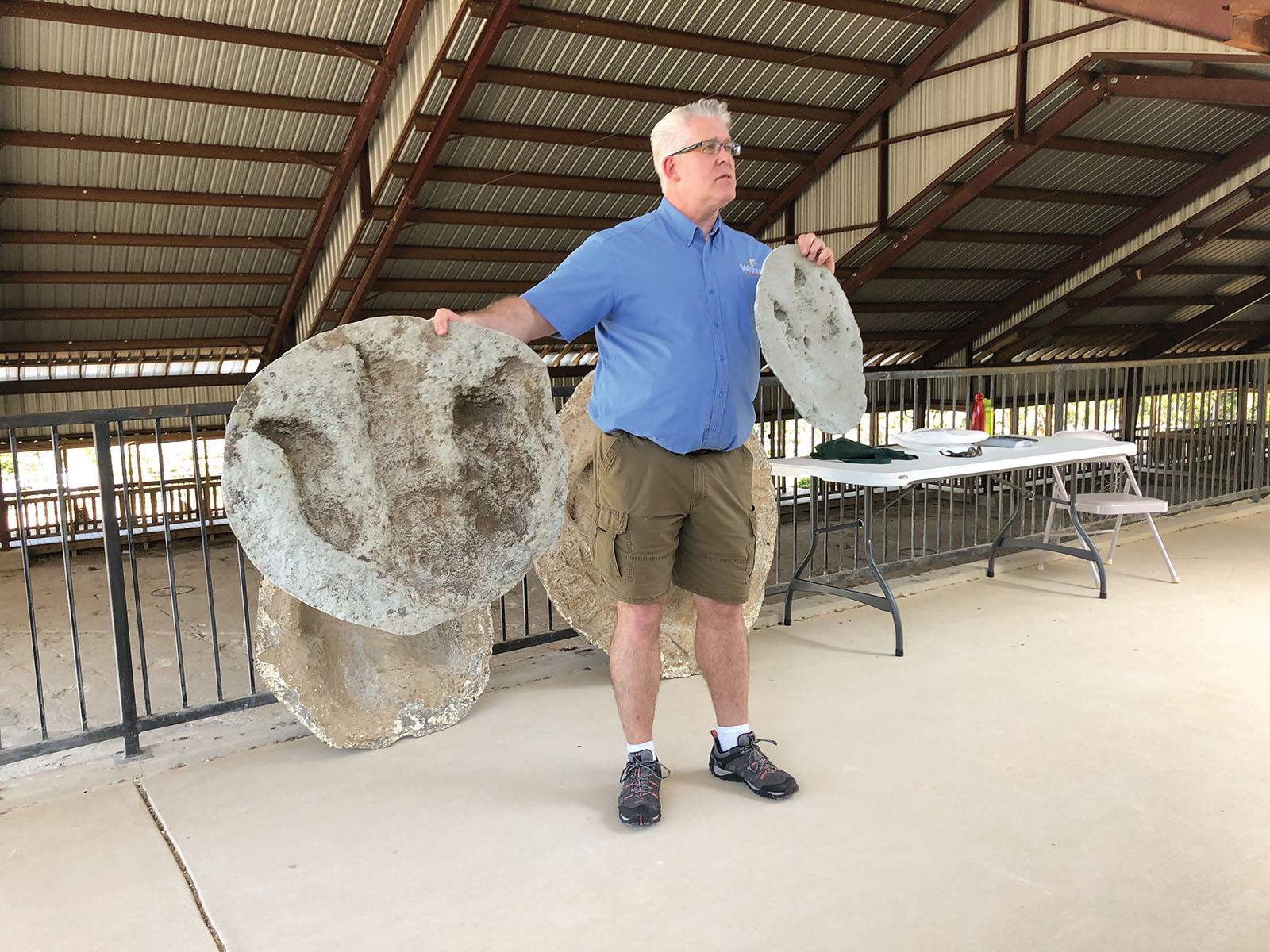
Dale Weisman
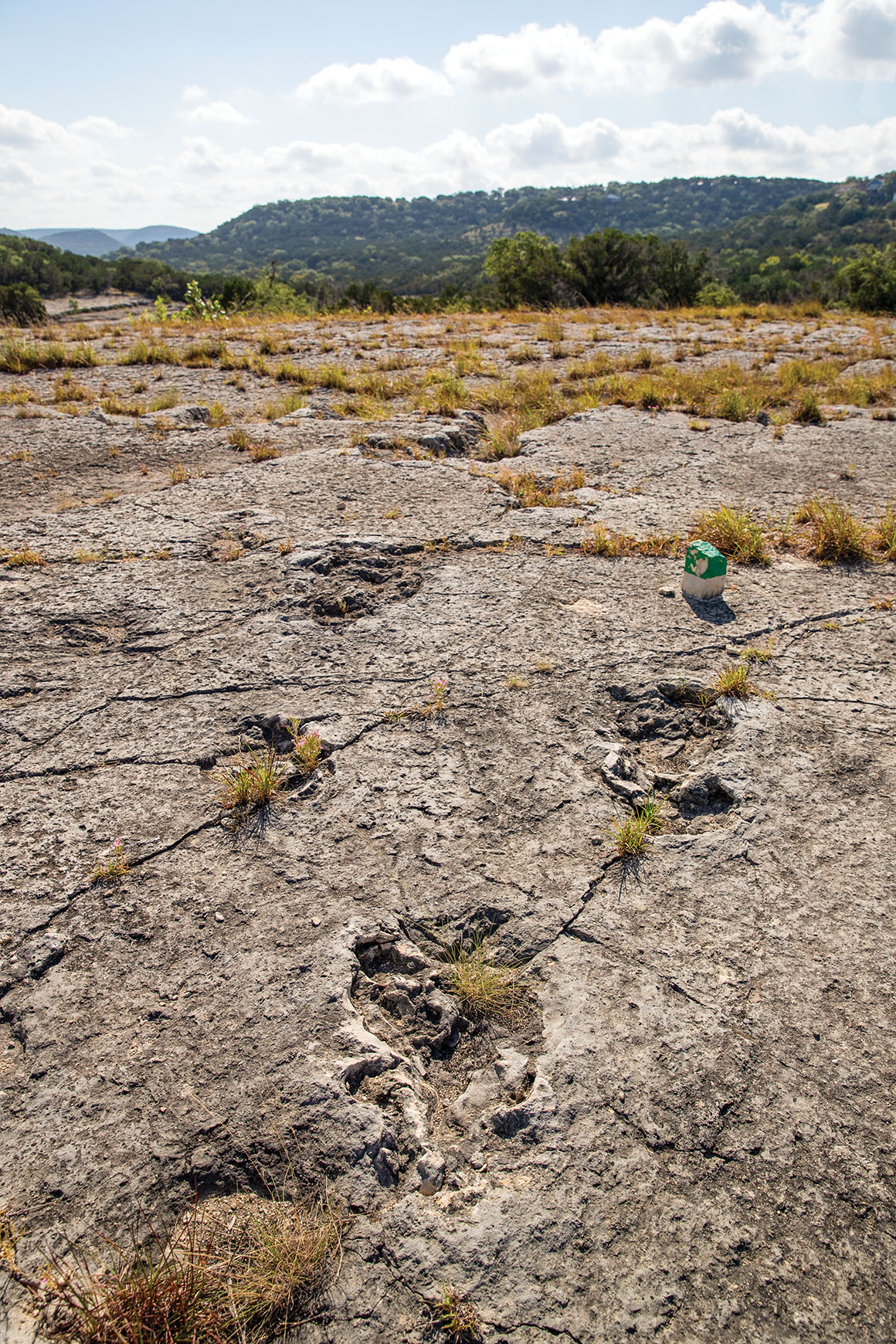
Maegan Lanham | TPWD
Related stories
» Like this story? If you enjoy reading articles like this, subscribe to Texas Parks & Wildlife magazine.


